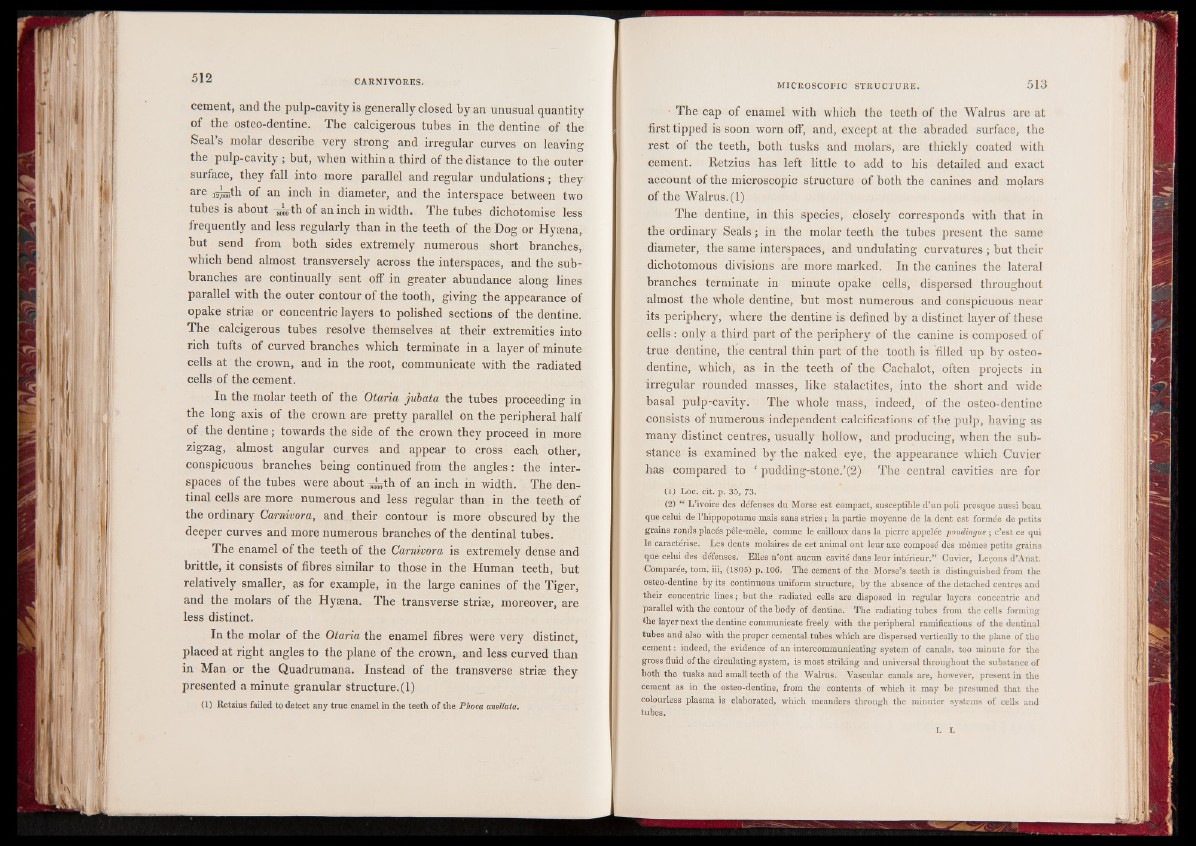
cement, and the pulp-cavity is generally closed by an unusual quantity
of the osteo-dentine. The calcigerous tubes in the dentine of the
Seal’s molar describe very strong and irregular curves on leaving
the pulp-cavity ; but, when within a third of the distance to the outer
surface, they fall into more parallel and regular undulations; they
are izSouth of an inch in diameter, and the interspace between two
tubes is about 'sjco'th of an inch in width. The tubes dichotomise less
frequently and less regularly than in the teeth of the Dog or Hyeena,
but send from both sides extremely numerous short branches,
which bend almost transversely across the interspaces, and the subbranches
are continually sent off in greater abundance along lines
parallel with the outer contour of the tooth, giving the appearance of
opake striae or concentric layers to polished sections of the dentine.
The calcigerous tubes resolve themselves at their extremities into
rich tufts of curved branches which terminate in a layer of minute
cells at the crown, and in the root, communicate with the radiated
cells of the cement.
In the molar teeth of the Otaria jubata the tubes proceeding in
the long axis of the crown are pretty parallel on the peripheral half
of the dentine; towards the side of the crown they proceed in more
zigzag, almost angular curves and appear to cross each other,
conspicuous branches being continued from the angles: the interspaces
of the tubes were about ^ t h of an inch in width. The dentinal
cells are more numerous and less regular than in the teeth of
the ordinary Carnivora, and their contour is more obscured by the
deeper curves and more numerous branches of the dentinal tubes.
The enamel of the teeth of the Carnivora is extremely dense and
brittle, it consists of fibres similar to those in the Human teeth, but
relatively smaller, as for example, in the large canines of the Tiger,
and the molars of the Hyaena. The transverse striae, moreover, are
less distinct.
In the molar of the Otaria the enamel fibres were very distinct,
placed at right angles to the plane of the crown, and less curved than
in Man or the Quadrumana. Instead of the transverse striae they
presented a minute granular structure. (1)
(1) Retzius failed to detect any true enamel in the teeth of the Phoca anellata.
• The cap of enamel with which the teeth of the Walrus are at
first tipped is soon worn off, and, except at the abraded surface, the
rest of the teeth, both tusks and molars, are thickly coated with
cement. Retzius has left little to add to his detailed and exact
account of the microscopic structure of both the canines and molars
of the Walrus. (1)
The dentine, in this species, closely corresponds with that in
the ordinary Seals ; in the molar teeth the tubes present the same
diameter, the same interspaces, and undulating curvatures ; but their
dichotomous divisions are more marked. In the canines the lateral
branches terminate in minute opake cells, dispersed throughout
almost the whole dentine, but most numerous and conspicuous near
its periphery, where the dentine is defined by a distinct layer of these
cells : only a third part of the periphery of the canine is composed of
true dentine, the central thin part of the tooth is filled up by osteo-
dentine, which, as in the teeth of the Cachalot, often projects in
irregular rounded masses, like stalactites, into the short and wide
basal pulp-cavity. The whole mass, indeed, of the osteo-dentine
consists of numerous independent calcifications of the pulp, having as
many distinct centres, usually hollow, and producing, when the substance
is examined by the naked eye, the appearance which Cuvier
has compared to ‘ pudding-stone.’(2) The central cavities are for
(1) Loc. cit. p. 35, 73.
(2) “ L’ivoire des defenses du Morse est compact, susceptible d’un poli presque aussi beau
que celui de Fhippopotame mais sans stries ; la partie moyenne de la dent est formée de petits
grains ronds placés pêle-mêle, comme le cailloux dans la pierre appelée poudingue ; c’est ce qui
le caractérisé. Les dents molaires de cet animal ont leur axe composé des mêmes petits grains
que celui des defenses. Elles n’ont aucun cavité dans leur intérieur.” Cuvier, Leçons d’Anat.
Comparée, tom. iii, (1805) p. 106. The cement of the Morse’s teeth is distinguished from the
osteo-dentine by its continuous uniform structure, by the absence of the detached centres and
their concentric lines ; but the radiated cells are disposed in regular layers concentric and
parallel with the contour of the body of dentine. The radiating tubes from the cells forming
the layer next the dentine communicate freely with the peripheral ramifications of the dentinal
tubes and also with the proper cemental tubes which are dispersed vertically to the plane of the
cement : indeed, the evidence of an intercommunicating system of canals, too minute for the
gross fluid of the circulating system, is most striking and universal throughout the substance of
both the tusks and small teeth of the Walrus. Vascular canals are, however, present in the
cement as in the osteo-dentine, from the contents of which it may be presumed that the
colourless plasma is elaborated, which meanders through the minuter systems of cells and
tubes.
L L